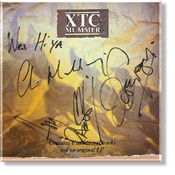 |
Mummer A very romantic idea. And it's all to do with the death of the old year and the resurrection - the birth of the new year. And I kind of like all that sort of shit. ~ Andy Partridge |
|
On
September 12, 2002 ~ Andy and I discussed the cover of the first XTC
album not to be toured.
|
| WL: Now Mummer - I think that was originally going to be called Fruits Fallen From… |
|
AP: Yeah, that was a combination of things. It was gonna be called Fallen From The Garden or Fruits Fallen From The Garden. But probably Fallen From The Garden, 'cause "fruits" - we thought, "Now hang on, do they think we're all gay or something?" But the idea was it was to be called Fallen From the Garden, and I did get together with artist Dave Dragon. Ken Ansel and Dave Dragon were two artists that worked for Design Clinic, and they were my interpreters if you see what I mean. They'd come down to my house and we'd sit in the kitchen and spread out loads of |
|
|
paper over the kitchen table. And I'd sketch stuff out, and they'd take all this stuff away and then come back down with the next stage, or whatever. But they came down to The Manor while we were doing Mummer and I said, "We think this album's going to be called Fallen From the Garden." And I liked the idea of the sort of fall from grace. And we are these characters that have been shunned from this beautiful place. And they actually came back down like a week or so later with a twelve-inch mockup sleeve, and I thought it was just a bit too comical. WL: Is that the one that appears in... One of the books has a sketch in which all the band members appear with fruit for heads. AP: - What happened was... I said, "Could we see it as if each of our heads was replaced by a fruit?" And the idea was |
|
then to scent each sleeve. To use scented cardboard. WL: A scratch and sniff sort of thing. AP: Well, kind of. But you just impregnate the cardboard inside with lemon, apple, orange, strawberry - whatever. And then the characters on the front, the four of us, would have these fruit heads. And you'd actually get a sort of random selection of which one it smelled like. And I didn't like the painting. It looked too - I don't know. It just looked too cutsie, and a bit stupid. WL: It looks sort of country, if it's the one I'm thinking of. A little folky, like folk art. AP: Yeah, I tried to get them to do it like the artist... What's his name? He went under the name Patrick. And he was a fake naïve artist. WL: [laughing] I don't know that I'm familiar with him. |
|
|
AP: Do you know The Beatles Illustrated Lyrics? WL: Yes. AP: Do you know, they're painted as Victorian children sat on the grass? WL: Yeah - yeah. AP: That's Patrick. And it was actually an author, called somebody Byrne. (John Byrne) A Scottish fellow. But he had a sort of fake career as a naïve artist. WL: Wow. I didn't know that. AP: He called himself Patrick. And I kind of liked that style. And I said, "Well, can we do it in that style. But instead of our faces I want these fruits." And they brought down this thing of... The garden was like a sort of an English country garden, with a manor house at one end of it. And it was all locked up and we were sat outside the iron gates, leaning on the iron gates with these fruits for heads. It just looked too cutsie, and a bit too children's-book. And so I thought, "This is going nowhere, there's too many metaphors all mixed up here. |
|
The smelly sleeves and the fruit heads, and we're out of favor from the garden." You know, and all that kind of thing. Loss of innocence and all that. And then the Mummer idea came up while I was taking a shit one day. [laughter] You know, you grab a book to take to the lavatory and I grabbed... I'll tell ya what I grabbed. Hang on a second, I'll see if I can find it. WL: Okay. AP: [seconds later] No, I can't see it. It's up there somewhere. It was a fifties encyclopedia. A children's encyclopedia. And I just sat on the shitter thinking, "What are we gonna call this album? What are we gonna dress it in?" And there was a little illustration of mummers, and I thought, "Oh yeah, they're very strange." And I started to read about mummers and thought, "Oh, this is intriguing." And I took myself down to the local library, in Swindon. And there were several books printed locally about mummers and mumming. |
|
|
The, how should I say this, the history of mumming. And I really liked it. I liked the idea that they were ordinary people; you know, like butcher, baker, candlestick-maker. Who did this archaic musical act once every year. WL: In costume. AP: In costume. And they made their own costumes. And they made them out of newspapers and rags, and so-forth. WL: Yeah. A very romantic idea. AP: A very romantic idea. And it's all to do with the death of the old year and the resurrection - the birth of the new year. And I kind of like all that sort of shit. [much laughter] And I really liked the idea. And I thought, "This is great." And then I explained it to Virgin and they said, "Oh no, so you're gonna hide?" And I said, "Yeah, it'll be us but you won't see us 'cause we'll have all these strips of paper and stuff all over our faces." They agreed to let us do the photo session. Then they saw the photographs and they said, "No, you're not doing |
|
this. [laughter] And by that time the record was due to come out. And so, unfortunately, the Mummer sleeve was a last second rush job. WL: Who finally put that together? The idea of the shadows on the… AP: Well, it was a case of... I still wanted to call it Mummer. We were all sold on the Mummer Idea. And I still liked the idea, the whole ethos of mummers and mumming. And basically, I got a call from the design clinic saying, "Look, Virgin are pestering us. They want the front cover by two days time. What is it to be?" As far as I was concerned it was one of those black and white shots of us in all the mummer gear. And then I came up with the last minute idea. I was thinking newspaper, and blah-blah. And I thought, "Well, paper dolls." You know, you tear out paper dolls and have three paper dolls. And I said, "Well, can you just cut out - out of card or something - roughly, so it looks like we do in that photograph?" You know, with a pointed hat and a conical hat. And then, just..."Can you crumple up some paper and try just photographing |
|
| shadows?" So that was just described down the phone. Because they had the studio time booked and, you know, we've got to produce this cover. A we've-got-to-get-it-done-tomorrow kind of thing. That was not satisfactory in my mind. It should have been the black and white photograph. |
|
In December of 2002, Andy
and I talked a bit about some Mummer singles.
|
|
|
WL: How about "Love on a Farmboy's Wages"?
AP: That was actually my wallet. I got together again with Dave Dragon [Design Clinic] and I said, "What I'd really like to do, to signify wages, is to make the double gatefold EP type sleeve a wallet." You know, 'cause you open a wallet and that's what shape it is. So, we photograph a wallet and we stamp the title on the front, then when you open it up it's full of stuff like the picture of his girlfriend inside, and some money, blah-blah, and a few other bits and pieces. And I thought that was kind of a nice object to signify the whole thing behind the song. Except, they said, "Do you want us to go and buy a wallet? What kind of wallet do you want us to get?" So I pulled out mine and said, "Well, something like that." And they said, "Well, can we use this?" I said, "Well, I guess so." So I just took out any personal bits and pieces that were in it and gave them my wallet. They took it away, photographed it and sent it back to me, but of course they'd gone and embossed in gold leaf on the front, the title. And I felt kind of embarrassed taking it over the pub after that. |
|
[laughter] You pull your wallet out and it's like a miniature version of your latest single. WL: [laughter] That's hilarious. AP: I don't know what I did with it after that. Maybe I took it 'round a charity shop or something, I can't remember. So someone out there might have my wallet with that embossed on the front in gold leaf. I had to buy a new wallet. I was just kind of embarrassed that I'd be pulling this out and it was almost like I was showing off or something, with an ad for the new single on the front of the wallet. [laughter] But that was actually my wallet. |
|
|
|
WL: You know, last time we talked you briefly mentioned the inspiration for the "Great Fire" single was a kinetic artist... AP: Oh, Moire. I think he was French and he did a lot of these optical patterns. WL: I've seen some stuff that I suppose was Moire. AP: Well, I'll tell you where you'll find them. If you have like these sort of science-y/explore-y type shops where for kids you can buy kind of interactive, vaguely scientific principled pastime game things. You can sometimes see these little sets of Moire patterns. You get like a book, and you get half a dozen patterns, and you can run the patterns across the book and where the lines on the optical pattern on the plastic interacts with the optical pattern of the drawing underneath, you get a third image. You know that principle, you sometimes see a stagecoach wheel on TV and it seems to be turning backwards. |
|
WL: Sure. AP: Our whole stage light show was built on the white lines principle. You know, interacting mechanical optical patterns from three projectors. So I thought that was a good thing to carry over into the artwork as well. |
